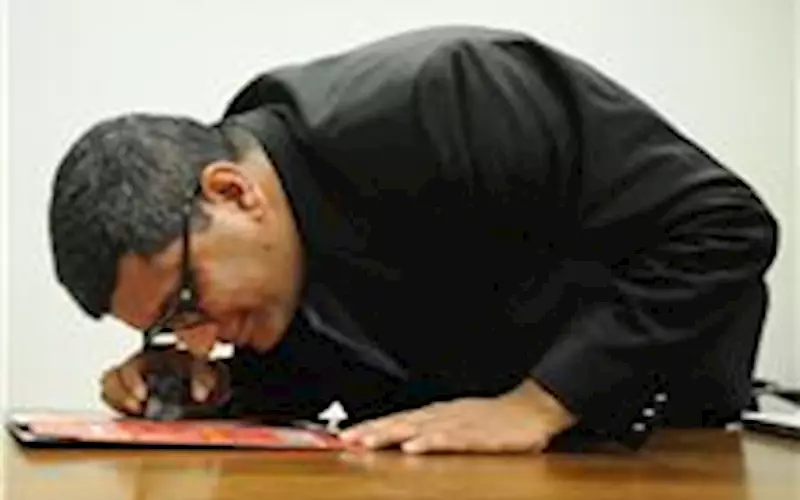Web offset manufacturers present at PrintPack 2013 showcased upgraded versions of their presses, which they believe would define usage patterns in newspapers and book printing
The mood, among the web offset manufacturers, was a tad low key at PrintPack. Rising costs are proving to be a roadblock to expansions. Most exhibitors told us that newspapers that had plans to launch new editions “have been put on hold because the newsprint price was witnessing volatility; plus the slowdown in advertising was worsening things”. And so, other than job lay-offs, one of the cost-cutting measures that newspapers are implementing is resizing their supplements.
At PrintPack, Manugraph the Kolhapur-based manufacturer of web offset presses unveiled the M360-BK bookline press.
M360B is a single-width, single circumference press and is the latest addition to the Manugraph stable. With a maximum speed up to 36,000 cph and an excellent price performance ratio, M 360B meets the printing requirements of book printers alike. With its inbuilt flexibility, M360 is capable of printing quarter fold and double parallel fold products. Short web path ensures print quality and reduced waste.
Pradeep Shah of Manugraph, says, “The growth in the newspaper is stagnant. The main reason may be due to low advertisement ratio. The new press is directed towards the book printing segment, which looks promising.”
The Printers House (TPH) launched a new web offset press with a design change. According to TPH, the machine will not be a product prototype but an actual production machine, which has been ordered by one of its foreign customers.
As a press manufacturer with understanding of the Indian market, TPH feels that printers are under tremendous pressure to curtail costs. George Kuriakose, assistant general manager-sales, TPH, shared that besides India, TPH foresees growth opportunities in China, Latin America and the CIS region.
Talking about future plans of the company, he says, “The most definite move would be towards optimal use of automation to minimise manpower and save cost. We would also look to consolidate our world-class manufacturing infrastructure by acquiring the best available equipment to manufacture our machines, and by adopting the most innovative business practices worldwide. With dwindling newspaper sales worldwide, except few countries, we have to gear up for a scenario where total orders will fall and the customer will become even more demanding.”
At the show, Manroland India highlighted the new Chromoman 4-1 web offset press designed specially for the Indian market. One Chromoman 4-1 press has been installed at The Times Of India Pune plant.
Pointing to key trends, Manroland has seen in the Indian print industry, Natasha Tandon manager – marketing and strategy, Manroland India, says, “The Indian print industry is undergoing a rapid transformation with the entry of efficient and productive technologies in the fields of printing and finishing. In addition, the company also highlighted its press console system, which was launched for the first time in Drupa.
Ronald Web Offset showcased the Ronald 4-Hi tower press. The machine was equipped with a spray bar dampening and remote inking system. This bearer-to-bearer type press has double RCR and digitised touch screen display.
Aditya Gupta, director, Ronald Web Offset, says, “Automation will lead the market, we are sending a machine to Europe with 64-pages capacity and one folder with automation. This is an repeat order from the same customer."
Gupta says, “Newspapers and books, both the customers are buying the machines, the textbook societies of India have made it compulsory to have in-house four-colour web offset printing press for book publishers, this is the reason why web offset machines are in demand.”
Prakash Webtech highlighted the new press, speedster 3600 with built-in reel stand. According to the manufacturer, this design will save 40% of space. As a result the length of the machine has reduced and height has increased. The machine is equipped with close-loop tension control system. Saurabh Gupta, director at Prakash Webtech, says, “Due to shorter length, the web path has reduced which mean saving on the paper and wastage." The press is equipped with a close loop tension control, spray dampening instead of cloth or brush. "This ensures the starting waste are reduced from thousands to hundred copies," says Gupta. The press has a speed of 36,000 impressions per hour and has a 546 mm cut-off with automatic insertion. This machine will be installed at Nai Dunia’s Raipur plant.
Pressline, which has participated in all ten previous editions of PrintPack, displayed its automatic splicer for web offset presses with a facility to run double roll. In addition, the company also launched a shaftless Prima tower.
Satish Bajwa, chairman and managing director, Pressline, says, “Many new technologies that we saw at Drupa are not meant for the “aam” printer and developing countries like ours.” He adds, “We need to showcase new equipment suitable for the majority at shows like PrintPack, which is emerging as one of the biggest exhibitions for the industry in South Asia.”
Goss International exhibited in association with its agent for India S L Kulkarni Cyril Graphics and focus on products for the Indian market. Goss presented solutions for newspaper, commercial and packaging applications. This includes the latest additions to the Goss newspaper portfolio, the Magnum HPS press and the 4x1 Universal XL press. For commercial printing applications, Goss emphasised the capabilities of its M-500 and M-600 press systems. According to Tim Mercy, vice president for Goss International in Asia, PrintPack offers a platform to address the requirements of this vast and varied market.
Sachin Shardul is the technical editor at PrintWeek India














 See All
See All